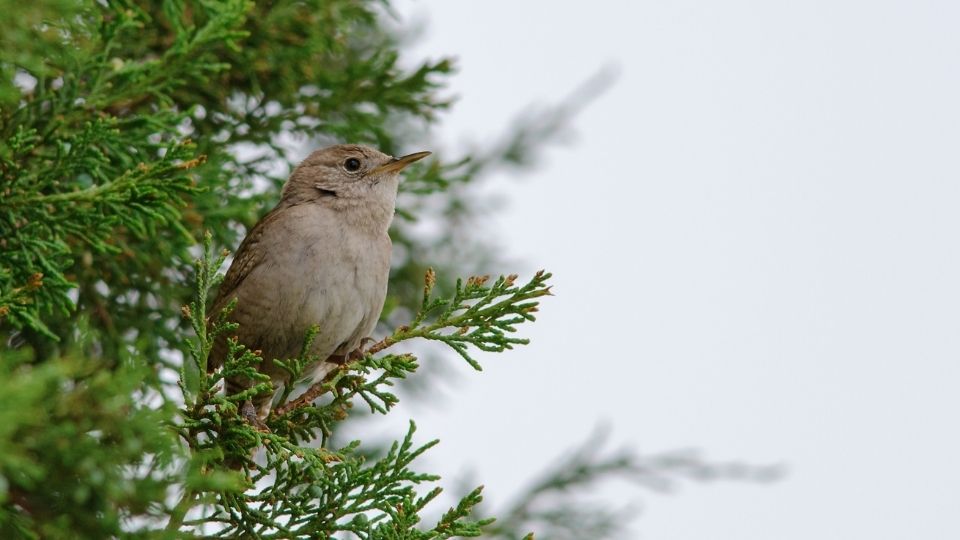Are Wrens and Sparrows different?
Yes, Wrens and Sparrow songbirds are different and belong to distinct species families. Wrens belong to a family of brown Passeriformes birds known as the Troglodytidae. Sparrows belong to a Passeriformes family known as Passerellidae.
These birds are some of the most common birds found in backyards. But how can you tell the difference between a wren vs sparrow?
Since they are both brown, they are often confused with one another. Often, they are confused with different species entirely.
They are very similar in several ways, including size and general color.
Side by side, they are a little easier to tell apart, but not without learning the key differences between the two.

House wrens have distinct striping called barring on their wings and tails and a slightly shorter tail positioned sometimes high or low.
House sparrows have a broader and longer tail with solid brown feathers that vary from dark to light.
To the untrained eye, these birds are still remarkably similar.
Whether you’re new to bird watching or an avid birder, with these tips and some key features, you’ll identify the two quickly in no time.
First off, let’s start with a side-by-side comparison.

What is the difference between the two songbirds?
While wrens and sparrows share a few similarities, they have far more differences beyond first glance.
Similar in color to sparrows, wrens have distinct barring on the wings and tail. Barring is black, white, or darker brown on medium brown feathers.
House sparrows’ color pattern is generally a combination of brown, black, and white. Females are entirely brown, and both male and female sparrows have plain brown or beige feathers on their abdomen.
Wrens’ bills are long and thin for catching insects. House sparrows have a shorter, conical beak that is black or yellow, depending on the bird’s gender and breeding stage.
Both wrens and sparrows have long tails, but wrens typically hold their tails cocked sharply upward while sparrows do not.
Sparrows are known to flash, wag or shake their tails. Wrens typically flip their tails up or down and hold them that way. A wren’s tail is rarely level with its body.
House sparrows are omnivores but prefer seeds and are ground foragers. They will eat moths and other insects, but millet, wheat, and wild grasses are far more common food for house sparrows.
Wrens are insectivores that eat spiders, arthropods, and other insects. Wrens have also been known to eat small frogs and lizards.
While sparrows are a common sight at bird feeders, wrens typically hunt bugs unless they visit the bird feeder for a taste of suet.
House sparrows have much longer legs than wrens, though they share a similar shade of brownish orange.
Now that you can tell the two apart when they are together let’s examine the individual characteristics that make them unique.

How do I identify a house sparrow?
House sparrows are brown, with a brown or beige belly. Feathers are free from barring, streaking, or stripes.
Adult male sparrows have darker brown feathers on their heads and shoulders. Black markings cover their eyes, chin, and the uppermost portion of their chest.
On some male house sparrows, the belly feathers are gray instead of beige. The belly feathers are plain with no markings.
Female house sparrows have brown feathers throughout, with slightly darker feathers on their wings. They have no markings on their chest and abdomen, which are feathered in a lighter brown or beige color.
Both male and female house sparrows have a small, conical bill that is black or yellow. The color of the beak depends on the bird’s gender and the breeding season. Younger sparrows tend to have lighter beaks.
House sparrows have long legs that are orangish-brown in color. These legs are perfect for hopping along the ground as they forage for their favorite foods.
Sparrows prefer to nest and forage in areas with heavy human traffic.

How do you identify a house wren?
Wrens are completely brown birds with markings on their wings and tail.
This small bird has a flat head and a fairly long, curved beak. Their beak is either completely gray or gray on top and light yellow on the bottom. The thin needle-like bill is perfect for snapping up insects quickly.
House wrens are short-winged, often keeping their long tails either cocked above the line of the body or slightly lowered.
With their tail down, they have a more slender appearance, similar to the house sparrow. Their tendency to hold their tails up shortens their profile, so they are more ball-shaped.
Rounded and squat-looking, house wrens are compact and small even as adults. Their short legs further enhance the squatness of their stature.
Many wren species have a distinct white brow line that gives the appearance of furrowed eyebrows. Combined with the noticeable yellow of its lower beak, the house wren can appear almost gruff when perched in a tree.
While they are not as aggressive as sparrows, house wrens are bold and brave despite their small size.

Do sparrows hurt wrens?
Since their introduction to North America, house sparrows have outcompeted many smaller and more timid songbirds for food, nesting areas, and resources.
House sparrows are considered invasive and will outcompete any bird for food. They are aggressive and bold, unafraid of other songbirds and even humans!
House sparrows are known to flock to outdoor eateries, fearlessly snatching scraps from humans nearby.
Their comfort with humans makes them especially adept at overwhelming shyer and smaller songbirds.
While they won’t attack or injure wrens directly, the scarcity of resources that often comes with sparrow flocks drives wrens and other songbirds away.
Sparrows are also known to take over birdhouses and nest boxes, which forces wrens and other songbirds to find alternate nesting sites.
Attracting and keeping house wrens in your yard is difficult if too many sparrows are around.
What birds are similar to both the house sparrow and the house wren?
With such wide varieties of brown bird species, it’s no wonder wrens and sparrows are often confused for each other and other small birds.
Wrens and house sparrows are commonly mistaken for finches, chickadees, brown-headed cowbirds, and great crested flycatchers.
Almost any small brown bird is likely to be misidentified as a sparrow or a finch.
While house sparrows and house wrens have several similarities, knowing the individual identifying markers makes them easy to tell apart.

